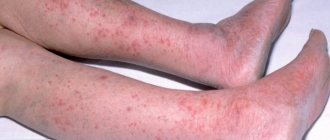- Symptoms of dyshidrosis
- Types of disease
- Complications of dyshidrosis
- Causes of crowberry
- Disease in children and pregnant women
- Diagnostics
- Treatment
- Drugs for the treatment of dyshidrosis
- Hardware procedures
- Diet for crowberry
- Duration of treatment and prevention of the disease
Dyshidrosis is a dermatological disease, otherwise called pompholyx or dropsy. The disease affects the sweat glands.
The main symptom is small blisters filled with fluid. They appear on the skin of the palms and legs and are accompanied by itching. After two or three days, dry crusts form in place of the blisters. As a rule, the disease manifests itself in the off-season.
Dyshidrosis in many cases is a type of allergy or occurs due to an imbalance in the functioning of the nervous system. This disease cannot be transmitted from the patient to other people.
Symptoms of dyshidrosis
The most important sign of dyshidrosis is damage to the skin of the feet and hands. If changes appear in other parts of the body, this means that the patient does not have water, but another dermatological disease.
The main signs of dyshidrosis:
- redness;
- swelling;
- bubbles filled with liquid;
- itching;
- peeling and sloughing of the affected skin.
When you touch the affected area, you may feel that the skin has become hotter.
Losterin cream in monotherapy of dyshidrotic eczema of the foot
Within a week, Losterin provides positive dynamics in the treatment of dyshidrotic eczema of the hands, the photo allows you to see the result: inflammatory processes stop, itching and redness disappear, the skin dries out, peeling decreases, cracks are epithelialized. With further use of Losterin, the cracks completely disappear (after 10 days).
Products from the Losterin line are characterized by a balanced composition. Active substances (naftalan, urea, zinc oxide, oils, medicinal plant extracts) are included in the preparations in an optimal combination, which allows for an effective therapeutic effect for dermatological problems. Another advantage of Losterin is that it does not contain hormones, dyes or fragrances, and is not addictive. Losterin cream and zinc-naphthalan paste are recommended for daily long-term use. They are used not only for the treatment of dyshidrotic eczema on the fingers and toes, but also for preventive purposes - to prolong remission.
Types of disease
There are three types of dyshidrosis, which differ in manifestation and severity:
- True dyshidrosis. At the initial stage, the disease manifests itself as redness, swelling and swelling of the skin. Then bubbles appear on it, the dimensions of which are about a millimeter and do not change in the future. True crowberry affects the skin of the palms. The foci of the disease are located at the base of the fingers. After 7-10 days, the blisters begin to open, which is accompanied by severe itching and burning. If the patient scratches the affected areas of the skin, this can lead to inflammation caused by infection in the wound.
- Dyshidrotic eczema. This is the most severe type, which if left untreated becomes a chronic disease. With eczema, fluid-filled blisters form on the palms and legs and increase in size. After some time, the bubbles open and dry out. The disease develops rapidly and causes a deterioration in overall health. The patient develops a headache, fever, and enlarged lymph nodes. With dyshidrotic eczema in children, appetite decreases and the child becomes lethargic. The disease most often develops with a hereditary predisposition or after severe stress.
- Dry lamellar pompholyx. The peculiarity of the disease is the absence of bubbles. Instead, the skin begins to itch slightly and areas of peeling appear. When itching, the skin can peel off in thin sheets, hence the name of the disease. It is important to know that with dry lamellar dyshidrosis, the skin should not be scratched, as this leads to inflammation and aggravation of the symptoms of the disease.
The disease develops mainly in residents of countries with a humid tropical or very dry climate, and tourists who prefer exotic holidays.
Treatment of dyshidrotic eczema
First, the correct diagnosis must be established. Usually, a visual examination is enough for the doctor to do this. But, in order to differentiate eczema from other dermatological diseases, he can refer you for laboratory analysis (skin scraping and fluid culture).
Treatment of dyshidrotic eczema on the fingers begins with eliminating the cause. If the pathology is caused by an internal disease, then it should be cured or the condition should be stabilized (for example, to compensate for diabetes mellitus). For this purpose, it is recommended to avoid contact with irritating substances, restore the functioning of the thyroid gland, and minimize the possibility of stressful situations.
You should not self-medicate, which can greatly aggravate the situation and significantly prolong the acute period. Look at the photo of dyshidrotic eczema on the fingers to see what kind of suffering you will experience for several months.
You cannot use medications that were prescribed to a friend with the same diagnosis. For dyshidrosis, the doctor selects treatment individually for each patient. It takes into account the stage of the disease, the appearance of the rash, and the presence of pyoderma.
Drug therapy for dyshidrotic eczema includes:
- antihistamines;
- anti-inflammatory drugs;
- hyposensitizing medications;
- diuretics;
- immunocorrective drugs;
- antibiotics belonging to the penicillin group (necessary when an infection occurs);
- sedatives (sedatives and sleeping pills, in severe cases – antidepressants);
- vitamin complexes (vitamins A, C, E, group B are especially necessary).
If necessary, the doctor will prescribe glucocorticosteroid ointments. But they can be used only until acute symptoms are relieved. With prolonged use, they become addictive and cause skin atrophy.
In case of suppuration, antiseptic ointments will be needed. It is recommended to pre-treat the skin with an antibacterial agent.
Anti-exudative ointments will allow the serous wells to dry out and heal. Products containing zinc, ichthyol, and tar have a similar effect. These include zinc-naphthalan paste “Losterin”.
With dyshidrotic eczema on the arms and legs, it is quite difficult to achieve remission. Therefore, an integrated approach is recommended, in which drug therapy is combined with herbal medicine and physiotherapeutic procedures. The treatment strategy should be selected by the doctor, taking into account the test results and the individual characteristics of the body.
When using herbal medicine, herbal baths are recommended (with a decoction of string, chamomile, mint, celandine, sage, yarrow). Hands or feet are immersed in the healing liquid for 20 minutes, and then the cream is applied.
Physiotherapeutic procedures will be an excellent addition:
- magnetic therapy;
- laser therapy;
- acupuncture;
- cryotherapy;
- ultraviolet irradiation;
- ultra-high frequency therapy;
- electrophoresis;
- electrosleep;
- darsonvalization;
- balneotherapy;
- cryotherapy;
- mud therapy;
- paraffin treatment.
They increase the body's resistance and protective abilities, and can reduce medication intake.
Another component of treatment is a diet that requires avoiding smoked foods, preserved foods, spicy and salty foods, sweets, citrus fruits, alcohol, and coffee. The main part of the diet should be soups, cereals, dairy and vegetable dishes. The diet will not only relieve the exacerbation, but will also help restore the functioning of the digestive system and normalize metabolic processes.
For dyshidrotic eczema of the palms, the photo shows its manifestations; the acute phase can last several months. Therefore, it is important not only to prolong remission, but also to shorten the acute period.
Causes of crowberry
Previously it was believed that the pathology develops when the ducts of the sweat glands become clogged, but at the moment this theory is completely refuted. Most often, the development of the disease is caused by a violation of the innervation of the sweat glands of the skin. This occurs due to a specific reaction of the nervous system to severe stress. In general, experts distinguish several common causes of pathology:
- hereditary predisposition;
- decreased immunity;
- endocrine disorders;
- dermatological diseases (fungi and infectious skin lesions, pyoderma);
- predisposition to allergies;
- diseases of the gastrointestinal tract;
- vegetative-vascular dystonia, other disorders of the nervous system;
- interaction with aggressive chemicals;
- psycho-emotional overload, mental fatigue;
- psychological trauma, severe stress;
- long-term use of antibiotics.
Disease in children and pregnant women
Not only adults, but also children are susceptible to the disease. In infancy, dropsy can occur due to breastfeeding if the child's mother does not eat properly. Breastfeeding women should not consume foods that may cause allergic reactions.
At an older age, dropsy in children occurs due to a hereditary predisposition or against the background of neuropsychic overload. The cause of the pathology can also be a disruption in the functioning of the immune system. During pregnancy, the risk of developing dyshidrosis increases, since in this condition the load on the female body increases. This leads to certain reactions from the nervous system. You should know that it is prohibited to use certain drugs to treat crow's feet in children and pregnant women, as they can cause unwanted side effects.
At what age do people get dyshidrosis?
A one-year-old baby may also develop dyshidrosis due to allergens in breast milk and/or the food he or she receives.
If a child has diathesis and is prone to atopic dermatitis, then the development of dyshidrosis occurs mainly before the age of three, but then its symptoms may disappear and reappear after 20 years.
During adolescence, hormonal changes in the body occur, accompanied by instability of the nervous system; dyshidrosis can occur against the background of stress and strong experiences. In addition, teenagers often sweat excessively, which also contributes to the development of the disease.
But since dyshidrosis is non-infectious, it is impossible to become infected with it, so you can even go to the pool (although during an exacerbation you should not do this due to the negative effect of chlorinated water on the skin).
Diagnostics
At the first signs of the disease, you should consult a dermatologist. The patient may also need to consult a gastroenterologist, allergist, or immunologist. The symptoms of the disease are similar to fungal infections and psoriasis, so a whole range of diagnostic procedures are prescribed. It includes:
- fungal analysis;
- allergy test;
- endoscopic examination;
- immunogram.
Thanks to differential diagnosis, the doctor will determine the exact nature of the disease and choose a treatment regimen.
Drugs for the treatment of dyshidrosis
Treatment of the disease includes medications for external use and oral administration. To reduce symptoms, affected areas of the skin are treated with antiseptics based on boric acid, chlorhexidine and other disinfecting compounds. To reduce swelling and redness, use zinc and salicylic ointment and other anti-inflammatory drugs.
Antihistamines are prescribed for oral administration, which relieve allergy symptoms. The patient is also prescribed sedatives, which reduce the sensitivity of the nervous system to psycho-emotional stress. To improve the functioning of the immune system, immunostimulants are used. In severe forms of the disease, glucocorticosteroids are indicated.
Diet for crowberry
Patients with dyshidrosis caused by food allergies need to review their diet and exclude foods that increase the manifestations of an allergic reaction. Such products include:
- dishes high in salt, spices, herbs;
- honey;
- citrus fruits, berries, bananas, melon;
- nuts;
- Fish and seafood;
- chocolate, cocoa, coffee;
- alcoholic drinks;
- eggs;
- foods high in sugar, baked goods.
When treating dyshidrosis, it is worth focusing on fermented milk products, cereals, fresh and boiled vegetables. The diet of a patient with chronic dyshidrosis should contain enough foods high in iron and phosphorus.
Introduction. Dyshidrosis (pompholyx), although it is a separate nosological unit in ICD-10 (code L30.1), in most manuals it is considered not as an independent disease, but as a dyshidrotic variant of true eczema. However, it cannot be denied that the phenomena of dyshidrosis can occur without reference to the eczematous process or other pathological conditions, for example, fungal infections of the skin. But even in such cases, some researchers consider the use of this term incorrect, preferring to replace it with “hyperhidrosis,” highlighting its variety with a special localization and clinical picture. Observing in the period from 2009 to 2013 the phenomena of dyshidrotic lesions of the hands and feet in 116 patients, we note that dyshidrosis itself (pompholyx) occurs depending on the profile of the office (mycological, adolescent) in different proportions and amounts to a total of 41.4 in the study group %, among other diseases, the following were identified: dyshidrotic eczema, dyshidrotic form of mycosis of the feet and microbial (mycotic) eczema, palmoplantar pustular psoriasis, allergic contact dermatitis. Accordingly, the main method of diagnosis was the exclusion of infectious and the mentioned chronic inflammatory dermatoses, both clinically and anamnestically. The average portrait of a patient with dyshidrosis is a young man or teenager, without gender differences, but with neuroticism noticeable to a non-specialist (emotional lability, asthenia, irritability, exhaustion, depression, concomitant vegetative disorders). The same reasons are often characteristic of hyperhidrosis, but the characteristic clinical picture of the formation of blisters on the hands and feet allows us to differentiate these two conditions, treating hyperhidrosis itself as an anomaly with increased sweating without the formation of blistering rashes specific to dyshidrosis. The above allows us to classify dyshidrosis as skin vegetosis. Therefore, in the complex therapy of pompholyx, it is rational to introduce the drug Bellataminal, which has proven itself in the treatment of various vegetoses. In addition, its sedative and M-anticholinergic effects directly and indirectly reduce sweating, as an important factor in pathogenesis. Purpose of the study. To evaluate the effectiveness of including Bellataminal in the complex therapy of dyshidrosis. Methods. The study included 48 people with a diagnosis verified by exclusion method. The study group consisted of 36 patients. Patients were recommended to have a rational regime of work and rest and a hygienic regime. The basis of the treatment regimen was the use of Bellataminal (1 tablet 3 times a day), external agents that reduce sweating, corneoprotectors, when opening blisters - retouching erosions with Fukortsin solution (1 time a day), and other symptomatic drugs according to indications. Treatment was carried out until the elements of the disease were completely resolved. The control group included the remaining 12 patients who, for various reasons, refused treatment with Bellataminal. The evaluation criteria were: time to resolution of clinical symptoms, tolerability and adherence to the chosen therapy. Results. The duration of treatment in the study group was 12.1 days; in the control group 16.4 days; Tolerability of therapy in the control group was better, including due to the normalization of mood and sleep. Adherence to therapy in the study group was higher compared to the control group, including due to a shorter treatment period, since lengthening the therapy time makes the use of topical agents less compliant. Conclusion. The inclusion of Bellataminal in treatment regimens for dyshidrosis (pompholyx) is pathogenetically justified and increases the effectiveness of combination therapy, which makes it possible to recommend it for widespread use in this disease.









